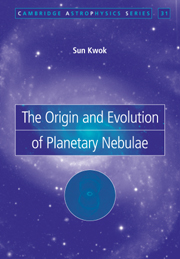Book contents
- Frontmatter
- Contents
- Preface
- 1 History and overview
- 2 Ionization structure of planetary nebulae
- 3 Nebular line radiation
- 4 Nebular continuum radiation
- 5 The neutral gas component
- 6 The dust component
- 7 Observations of the central star of planetary nebulae
- 8 Morphologies of planetary nebulae
- 9 Problems and questions
- 10 Asymptotic giant branch stars – progenitors of planetary nebulae
- 11 Evolution of the central stars
- 12 Formation of planetary nebulae
- 13 Dynamical evolution of planetary nebulae
- 14 Protoplanetary nebulae – the transition objects
- 15 Evolution to the white dwarf stage
- 16 Distances to planetary nebulae
- 17 Comparison between evolutionary models and observations
- 18 PN in the galactic context
- 19 Chemical abundances
- 20 Planetary nebulae in other galaxies
- 21 Concluding remarks
- References
- Appendix List of symbols and abbreviations
- Subject index
8 - Morphologies of planetary nebulae
Published online by Cambridge University Press: 04 November 2009
- Frontmatter
- Contents
- Preface
- 1 History and overview
- 2 Ionization structure of planetary nebulae
- 3 Nebular line radiation
- 4 Nebular continuum radiation
- 5 The neutral gas component
- 6 The dust component
- 7 Observations of the central star of planetary nebulae
- 8 Morphologies of planetary nebulae
- 9 Problems and questions
- 10 Asymptotic giant branch stars – progenitors of planetary nebulae
- 11 Evolution of the central stars
- 12 Formation of planetary nebulae
- 13 Dynamical evolution of planetary nebulae
- 14 Protoplanetary nebulae – the transition objects
- 15 Evolution to the white dwarf stage
- 16 Distances to planetary nebulae
- 17 Comparison between evolutionary models and observations
- 18 PN in the galactic context
- 19 Chemical abundances
- 20 Planetary nebulae in other galaxies
- 21 Concluding remarks
- References
- Appendix List of symbols and abbreviations
- Subject index
Summary
Although PN are well known for their ring-shape appearance, they in fact have a diverse range of morphologies. Using photographs that he took at the Lick Observatory, Curtis (1918) was the first to arrange PN into different classes based on their appearances. The origin of such diverse shapes has remained a mystery for a long time. For example, the well known Ring Nebula (NGC 6720) has an elliptical ring appearance. The most obvious interpretation is that this represents a three-dimensional hollow shell projected onto the sky. However, the actual observed surface brightness of the “hole” in comparison to the shell is too low (∽1:20) to be consistent with this model (Minkowski and Osterbrock, 1960). The observed intensity distribution is in fact more compatible with an open-ended toroid viewed end on (Khromov and Kohoutek, 1968). Although this model gives a good approximation to the observed image, the origin of such a toroid is not explained. The physical origin of the different morphologies of PN and how they evolve to such forms therefore represents one of the greatest challenges in PN research.
Morphological classifications
Curtis (1918) classified his sample of 78 PN into helical, annular, disk (uniform and centrally bright), amorphous, and stellar. Subsequent classification schemes often use similar descriptive forms: stellar, disk, irregular, ring, anomalous (Perek & Kohoutek, 1967); elliptical, rings, bipolar, interlocking, peculiar, and doubtful (Greig, 1971; Westerlund and Henize, 1967); and round, elliptical, and butterfly (Balick, 1987).
- Type
- Chapter
- Information
- The Origin and Evolution of Planetary Nebulae , pp. 89 - 100Publisher: Cambridge University PressPrint publication year: 2000

